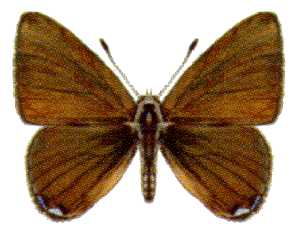
Butterflies are winged insects from the lepidopteran suborder Rhopalocera, characterized by large, often brightly coloured wings that often fold together when at rest, and a conspicuous, fluttering flight. The group comprises the superfamilies Hedyloidea and Papilionoidea. The oldest butterfly fossils have been dated to the Paleocene, about 56 million years ago, though they may have originated earlier.

The large blue is a species of butterfly in the family Lycaenidae. The species was first defined in 1758 and first recorded in Britain in 1795. In 1979 the species became mostly extinct in Britain but has been successfully reintroduced with new conservation methods. The species is classified as "near threatened" on the IUCN Red List of Threatened Species. Today P. arion can be found in Europe, the Caucasus, Armenia, western Siberia, Altai, north-western Kazakhstan and Sichuan.

The common blue butterfly or European common blue is a butterfly in the family Lycaenidae and subfamily Polyommatinae. The butterfly is found throughout the Palearctic and has been introduced to North America. Butterflies in the Polyommatinae are collectively called blues, from the coloring of the wings. Common blue males usually have wings that are blue above with a black-brown border and a white fringe. The females are usually brown above with a blue dusting and orange spots.

Lycaenidae is the second-largest family of butterflies, with over 6,000 species worldwide, whose members are also called gossamer-winged butterflies. They constitute about 30% of the known butterfly species.

The hairy-footed dunnart is a dunnart that has silver hairs on the soles of it hind feet accompanied by long hair on the side of its sole. It is an Australian marsupial similar to the Ooldea dunnart, with its upper body yellow-brown and lower body white in colour. Its total length is 14.7–18 cm (5.8–7.1 in); its average body length is 7.2–8.5 cm (2.8–3.3 in) with a tail of 7.5–9.5 cm (3.0–3.7 in). Its ear length is 15 mm (0.59 in). It weighs between 13 and 19 g. Its tail is thin and pinkish-white and can be thickened at the base.

Illidge's ant-blue butterfly, is an endangered species of butterfly endemic to Australia. This species can be found at six confirmed sites: Mary River Heads, Beaver Rock and Maaroom in the Fraser Coast Region (Queensland); Redland Bay and Point Halloran in the City of Redland (Queensland), and Brunswick Heads.

The grey ant-blue is a butterfly native to Australia.

Acrodipsas is a genus of butterflies in the family Lycaenidae. There are ten species in this genus all endemic to the Australasian realm:
The Geelong Field Naturalists Club (GFNC) is an Australian regional amateur scientific natural history and conservation society which was founded in 1961 by Trevor Pescott. It is based in Geelong, Victoria, with the aims of:

Jalmenus evagoras, the imperial hairstreak, imperial blue, or common imperial blue, is a small, metallic blue butterfly of the family Lycaenidae. It is commonly found in eastern coastal regions of Australia. This species is notable for its unique mutualism with ants of the genus Iridomyrmex. The ants provide protection for juveniles and cues for adult mating behavior. They are compensated with food secreted from J. evagoras larvae. The ants greatly enhance the survival and reproductive success of the butterflies. J. evagoras lives and feeds on Acacia plants, so butterfly populations are localized to areas with preferred species of both host plants and ants.

Acrodipsas brisbanensis, the bronze ant-blue or large ant-blue, is a butterfly of the family Lycaenidae. It is found in Australia.

Acrodipsas cuprea, the copper ant-blue or cuprea ant-blue, is a butterfly of the family Lycaenidae. It is found in Australia, from southern Queensland to Victoria.

Acrodipsas myrmecophila, the small ant-blue, is a butterfly of the family Lycaenidae. It is found in the south-east of Australia.

Acrodipsas arcana, the black-veined ant-blue or arcana ant-blue, is a butterfly of the family Lycaenidae. It is found inland on hills in southern Queensland and northern New South Wales in Australia.

Acrodipsas aurata, the golden ant-blue, is a butterfly of the family Lycaenidae. It is found in the mountains of New South Wales and northern Victoria in Australia.
Acrodipsas decima, the Decima ant-blue, is a butterfly of the family Lycaenidae. It is found in a small area of the Northern Territory in Australia.
Acrodipsas mortoni, the brown ant-blue, is a butterfly of the family Lycaenidae. It is found in inland New South Wales and southern Queensland in Australia.

The silky hairstreak or chlorinda hairstreak is a butterfly belonging to the family Lycaenidae. The species was first described by Emile Blanchard in 1848. It occurs in Australia. It is the only species in the monotypic genus Pseudalmenus, described by Hamilton Herbert Druce in 1902.












